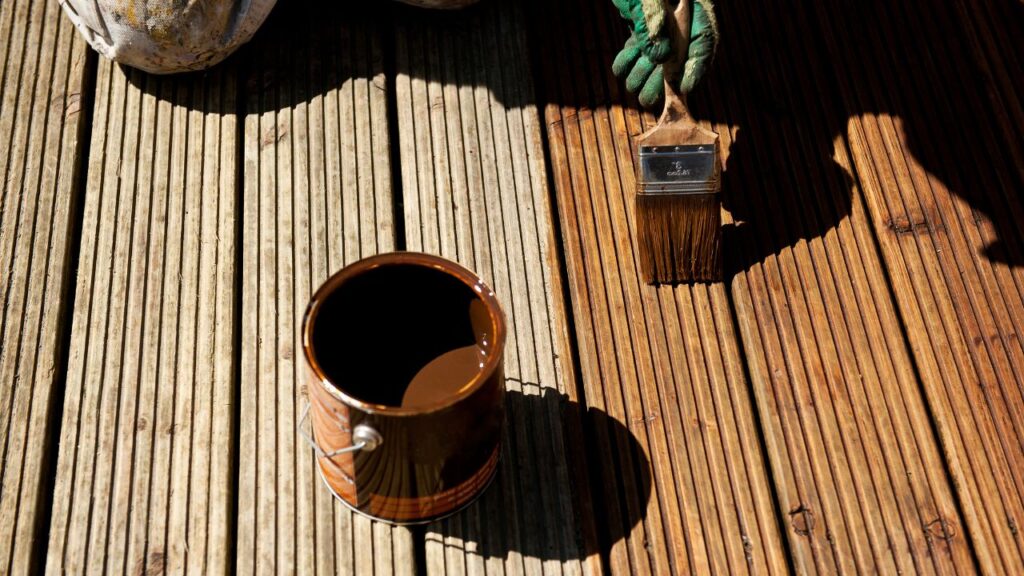Every homeowner appreciates the beauty and functionality of a well-maintained deck. It’s a space where families create memories, from summer barbecues to stargazing nights. A fresh coat of paint can revive an old deck, making it more appealing while protecting it from the elements. Here, we will look at all the ins and outs of painting a deck, ensuring you have all the information needed to take on this do-it-yourself task.
Importance Of Painting A Deck
Why should you consider painting your deck? It’s not just about aesthetics. Painting a deck adds a protective layer against weather damage, slows wood rot, and prevents the deck from becoming slippery when wet. It’s vital for prolonging the life of your wooden deck. With a fresh coat of paint, your deck can resist sun damage, harsh winters, and rain, keeping it sturdy and beautiful for years to come.

Tools & Materials Needed
Before you get started, you’ll need to gather some essential tools and materials. These include:
- Paint: High-quality, exterior-grade, acrylic-based deck paint is often the best choice for durability and protection.
- Paintbrushes and Rollers: You’ll need a good-quality brush for detailed spots and edges, and a roller with an extended handle for larger areas.
- Paint Scraper: This tool will help you remove peeling or chipped paint from previously painted decks.
- Sanding Tools: Depending on the size of your deck, you may need power sanders, sanding blocks, or sandpaper to prepare the surface for painting.
- Cleaning Supplies: Washing the deck is a crucial step, so you’ll need a suitable deck cleaning solution and a stiff brush or broom.
When To Paint A Deck?
The timing and weather conditions are critical factors when painting a deck. Ideally, painting should be done during a dry, mild day. Avoid painting in direct sunlight, as this can cause the paint to dry too quickly and unevenly. Also, avoid painting when rain is forecasted within 24 hours. If it’s too cold, the paint may not adhere properly; if it’s too hot, the paint may dry too quickly, leaving brush marks and streaks.
Generally, the best time to paint a deck is in late spring or early fall when temperatures are moderate. Remember, the deck must be completely dry before you start painting, so plan accordingly.
Timing is also crucial. Start early in the day to give your deck plenty of time to dry before evening dew sets in. This also gives you a chance to apply a second coat, if needed. Be patient and don’t rush the process. Remember, a well-painted deck is worth the time and effort, adding beauty and longevity to your outdoor space.
Preparation Steps: Inspect, Repair, & Clean
The first step in painting a deck is preparation. This involves inspecting the deck for any visible damage, such as cracked boards, chips, or loose fasteners. If you spot any damage, it’s crucial to repair it right away. Replacing damaged wood and securing loose hardware helps ensure the longevity of your painted deck.
Cleaning the deck thoroughly is the next step. You’ll need to scrub away dirt, mildew, and old debris using a suitable deck cleaning solution and a stiff brush or broom. Cleaning the deck serves two purposes. Firstly, it provides a clean surface for the paint to adhere to. Secondly, it helps to reveal any hidden damage that may need repair. Remember, a clean deck is a healthy deck, and a healthy deck will hold paint better and last longer.
Removing Old Paint & Sanding The Surface
Once your deck is clean and any repairs have been made, it’s time to remove any old paint. This can be done using a paint scraper. Be gentle when scraping away old paint to avoid damaging the wood underneath. The goal is to create a smooth, paint-free surface that will take the new paint well.
After the old paint has been removed, the next step is to sand the deck. Sanding smooths out any rough edges and surface imperfections. Depending on the size of your deck, you may need to use power sanders, sanding blocks, or sandpaper. Be thorough with your sanding – the smoother the surface, the better the paint will adhere. Once the sanding is complete, give the deck another thorough cleaning to remove any dust or debris.
Choosing The Right Paint & Primer
Now that your deck is clean, repaired, and sanded, it’s time to choose your paint. Not just any paint will do. You’ll need high-quality, exterior-grade, acrylic-based deck paint. This type of paint is designed to withstand weather damage and protect your deck from the elements.
The color of the paint is up to you. Consider the overall aesthetic of your home and outdoor space when choosing a color. Remember, darker colors tend to absorb more heat, which could make your deck uncomfortably hot in the summer. Lighter colors, on the other hand, reflect heat, making your deck a more comfortable place to be on hot days.
In addition to paint, you may also want to consider using a primer. Primer is applied before the paint and helps the paint adhere better to the wood. It can also help prevent stains and wood knots from showing through the paint. While not always necessary, using a primer can improve the look and longevity of your paint job.
Whichever paint and primer you choose, make sure to mix them thoroughly before use. This will ensure a consistent finish and help avoid any color variations.
Painting Process
To ensure a long-lasting and visually pleasing result, the painting process needs to be done with consideration and care. The first step is stirring your chosen deck paint thoroughly before use. This is vital to achieve a uniform finish and avoid any color inconsistencies.
When painting, start from the furthest corner and work your way towards your exit point. This strategy prevents you from stepping on wet paint. Use a brush to cut in edges and corners, then switch to a roller for larger surface areas. This technique provides an even coat and makes the process more efficient.
Take special care when sealing the ends of the boards. These areas are particularly prone to moisture penetration and require extra protection. Apply the paint generously to these spots to ensure a robust barrier against the elements.
Drying, Recoating, & Curing
Once the first coat is applied, let it dry completely. This process usually takes at least two hours, but it can vary based on the paint manufacturer’s instructions. Avoid the temptation to rush this step. A fully dried first coat provides a solid base for the next one and enhances the paint’s durability.
When the first coat is thoroughly dry, apply a second one. This step improves the coverage and extends the paint’s lifespan. Again, let the second coat dry entirely before moving on to the next stage.
After the second coat, the deck needs to cure. This process can take anywhere from 24 to 48 hours, depending on the paint and weather conditions. During this time, avoid walking on the deck or replacing furniture. This patience will pay off with a beautifully painted, durable deck.
Aftercare & Maintenance
Once the paint has fully cured, the deck is ready for use. However, the work doesn’t stop here. Regular maintenance is key to extending the life of your paint job. Regularly clean the deck to remove dirt and prevent the accumulation of debris that could damage the paint.
Despite your best efforts, you might notice small chips or wear over time. When this happens, perform touch-ups as necessary. This proactive approach keeps your deck looking its best and helps preserve the paint job.
In conclusion, painting a deck is a process that requires preparation, careful execution, and regular maintenance. However, with the right approach, you can transform your deck into an inviting outdoor living space that stands up to the elements and stands the test of time.






